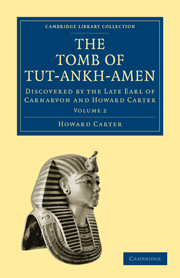Book contents
- Frontmatter
- PREFACE
- Contents
- LIST OF PLATES
- INTRODUCTION. REMARKS UPON EGYPTIAN ART
- CHAPTER 1 TUT-ANKH-AMEN
- CHAPTER 2 THE TOMB AND BURIAL CHAMBER
- CHAPTER 3 CLEARING THE BURIAL CHAMBER AND OPENING THE SARCOPHAGUS
- CHAPTER 4 THE STATE CHARIOTS
- CHAPTER 5 THE OPENING OF THE THREE COFFINS (SEASON 1925–26)
- CHAPTER 6 POINTS OF INTEREST IN EGYPTIAN BURIAL CUSTOMS
- CHAPTER 7 THE EXAMINATION OF THE ROYAL MUMMY
- APPENDICES
- APPENDIX I REPORT UPON THE EXAMINATION OF TUT-ANKH-AMEN'S MUMMY
- APPENDIX II THE CHEMISTRY OF THE TOMB
- APPENDIX III REPORT ON THE FLORAL WREATHS FOUND IN THE COFFINS OF TUT-ANKH-AMEN
- APPENDIX IV NOTES ON OBJECTS FROM THE TOMB
- APPENDIX V REPORT ON THE EXAMINATION OF SPECIMENS FROM THE TOMB OF KING TUT-ANKH-AMEN
- APPENDIX VI DESCRIPTION OF THE OBJECTS. PLATES XXXVII-LXXXVIII
- INDEX
- Plate section
- Plate section
APPENDIX II - THE CHEMISTRY OF THE TOMB
Published online by Cambridge University Press: 05 March 2012
- Frontmatter
- PREFACE
- Contents
- LIST OF PLATES
- INTRODUCTION. REMARKS UPON EGYPTIAN ART
- CHAPTER 1 TUT-ANKH-AMEN
- CHAPTER 2 THE TOMB AND BURIAL CHAMBER
- CHAPTER 3 CLEARING THE BURIAL CHAMBER AND OPENING THE SARCOPHAGUS
- CHAPTER 4 THE STATE CHARIOTS
- CHAPTER 5 THE OPENING OF THE THREE COFFINS (SEASON 1925–26)
- CHAPTER 6 POINTS OF INTEREST IN EGYPTIAN BURIAL CUSTOMS
- CHAPTER 7 THE EXAMINATION OF THE ROYAL MUMMY
- APPENDICES
- APPENDIX I REPORT UPON THE EXAMINATION OF TUT-ANKH-AMEN'S MUMMY
- APPENDIX II THE CHEMISTRY OF THE TOMB
- APPENDIX III REPORT ON THE FLORAL WREATHS FOUND IN THE COFFINS OF TUT-ANKH-AMEN
- APPENDIX IV NOTES ON OBJECTS FROM THE TOMB
- APPENDIX V REPORT ON THE EXAMINATION OF SPECIMENS FROM THE TOMB OF KING TUT-ANKH-AMEN
- APPENDIX VI DESCRIPTION OF THE OBJECTS. PLATES XXXVII-LXXXVIII
- INDEX
- Plate section
- Plate section
Summary
It is proposed to describe from a purely chemical aspect the materials used in the construction of the tomb and the composition of some of the objects found. The description will be as nontechnical as possible, and although a very large number of chemical analyses have been made, the citing of percentage compositions will be avoided, the results being given instead in the form of conclusions derived from a careful consideration of the analyses, and from a long and varied experience of materials in general and of Egyptian materials in particular.
The tomb, including the steps leading down to it, is cut out of the solid rock. This rock is a white, amorphous limestone containing flint and flinty masses, often of considerable size, and also occasional veins of calcite.
The outermost doorway of the tomb, as also three inner doorways, were all closed with irregular-shaped blocks of limestone put together without mortar, but thickly covered on the outside with a light-coloured grey plaster that is still very hard and durable and corresponds in composition to plaster of Paris; the grey colour is due to the presence of a little unburned fuel.
A considerable amount of misconception exists concerning the nature of the plaster employed by the ancient Egyptians and it is generally-wrongly described, often as lime plaster. It is, however, crude gypsum simply burned and powdered. Gypsum occurs largely in Egypt and is worked at the present time in the vicinities of both Cairo and Alexandria, and in the district stretching south from Cairo to Beni Suef.
- Type
- Chapter
- Information
- The Tomb of Tut-Ankh-AmenDiscovered by the Late Earl of Carnarvon and Howard Carter, pp. 162 - 188Publisher: Cambridge University PressPrint publication year: 2010First published in: 1927



